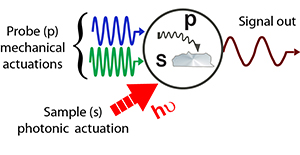Scientists at the Department of Energy’s Oak Ridge National Laboratory (ORNL) are developing a microscope which will enable analysis of synthetic and biological materials while examining the surface’s physical and chemical properties both on and beneath the surface.
 A combination of carefully tuned mechanical and photonic excitations of the sample and probe allow for decoding of chemical and physical properties
A combination of carefully tuned mechanical and photonic excitations of the sample and probe allow for decoding of chemical and physical properties
The team is led by principal investigator Ali Passian of ORNL’s Quantum Information System group. The novel hybrid photonic mode-synthesizing atomic force microscope, which is a combination of two fields - nanomechanical microscopy and nanospectroscopy, is illustrated in Nature Nanotechnology.
“Our microscope offers a noninvasive rapid method to explore materials simultaneously for their chemical and physical properties,” Passian said. “It allows researchers to study the surface and subsurface of synthetic and biological samples, which is a capability that until now didn’t exist.”
The microscope has the capacity for probable discoveries in the future as it possesses high resolution and subsurface spectroscopic capabilities. It however, continues to possess all the key benefits of an atomic force microscope.
The originality of the instrument and technique lies in its ability to provide information about a material’s chemical composition in the broad infrared spectrum of the chemical composition while showing the morphology of a material’s interior and exterior with nanoscale – a billionth of a meter – resolution.
Passian
This unique microscope will enable users to analyze samples ranging from engineered nanostructures and nanoparticles to naturally occurring plant cells, biological polymers and tissues.
The first application in which this microscope was deployed in the DOE’s BioEnergy Science Center was for analyzing plant cell walls, which were under numerous treatments in order to achieve submicron characterization. The cell wall of a plant is a layered nanostructure made up of biopolymers such as cellulose. Researchers are looking to convert these biopolymers to free the functional sugars and discharge energy.
An instrument constructed previously at ORNL was capable of imaging poplar cell wall structures from which exceptional topological data could be procured, thereby promoting basic research in sustainable biofuels.
This made the ORNL scientists to visualize several other applications.
An urgent need exists for new platforms that can tackle the challenges of subsurface and chemical characterization at the nanometer scale. Hybrid approaches such as ours bring together multiple capabilities, in this case, spectroscopy and high-resolution microscopy.
Rubye Farahi
Closer observation of the new hybrid microscope reveals a photonic module which can be integrated into a mode-synthesizing atomic force microscope. Furthermore, the microscope’s modular aspect allows several radiation sources such as non-coherent monochromatic or polychromatic sources and tunable lasers, to be housed.
Other contributors to the article, titled “Opto-nanomechanical spectroscopic material characterization,” are Brian Davison of ORNL and former ORNL researchers Laurene Tetard and Thomas Thundat.
References